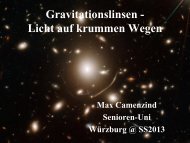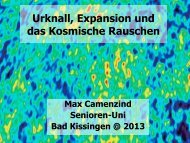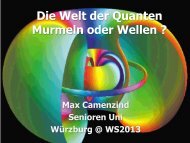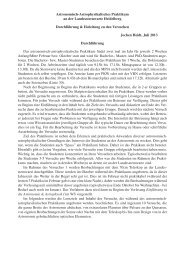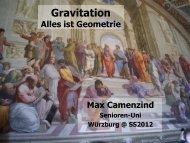Contents List of Figures
Contents List of Figures
Contents List of Figures
You also want an ePaper? Increase the reach of your titles
YUMPU automatically turns print PDFs into web optimized ePapers that Google loves.
6.2 Jets as Super(magneto)sonic Collimated Plasma Flows 277<br />
kinetic power, as well as to find self-consistent models for the particle acceleration<br />
and flow patterns. As telescopes and analysis techniques have improved the level <strong>of</strong><br />
detail obtained, it has become apparent, however, that the observed properties are<br />
not very simple and much harder to interpret than most simple models predict.<br />
Radiative MHD with NIRVANA C: In the following we work in the one–<br />
component approximation for the dynamical part, but include cooling for the evolution<br />
<strong>of</strong> different atomic species [11]. The evolution <strong>of</strong> the jet plasma is given by the<br />
continuity equation for the density ρ, the Euler equations for the momenta ρ V which<br />
have pressure gradient and Lorentz forces as source terms. The magnetic fields B<br />
evolve according to the induction equation, and the time evolution <strong>of</strong> the internal<br />
energy e is determined by advection, compression and cooling (the K–term)<br />
∂ρ<br />
∂t + ∇ · (ρ V ) = 0 (673)<br />
∂ρ V<br />
∂t + ∇ · (ρ V ⊗ V ) = −∇P − 1<br />
8π ∇ B 2 + 1<br />
4π ( B · ∇) B (674)<br />
∂e<br />
∂t + ∇ · (e V ) = −P (∇ · V ) − K (675)<br />
∂ B<br />
∂t = ∇ × ( V × B) (676)<br />
P = (Γ − 1)e . (677)<br />
These equations are implemented in codes such as ZEUS3D and NIRVANA C [22],<br />
or more modern versions based on shock capturing methods [23].<br />
Cooling Functions for Low–Density Plasmas: Sutherland & Dopita [21] have<br />
presented the equilibrium cooling functions for optically thin plasmas. These can<br />
easily built into the code NIRVANA C. Some functions are terminated before reaching<br />
10 4 K when the internal photoionization halts the cooling. The functions represent<br />
a self-consistent set <strong>of</strong> curves covering a wide grid <strong>of</strong> temperature and metallicities<br />
using recently published atomic data and processes. The results have implications<br />
for phenomena such as cooling flows and for hydrodynamic modelling which<br />
include gas components. NIRVANA C can however also handle non–equilibrium<br />
cooling for an entire set <strong>of</strong> atomic species. Then the above equations must be supplemented<br />
with a network <strong>of</strong> time evolution for various species. In cases, where<br />
cooling is very rapid compared to dynamical time–scales, this network has to be<br />
solved by means <strong>of</strong> time–implicit methods.



